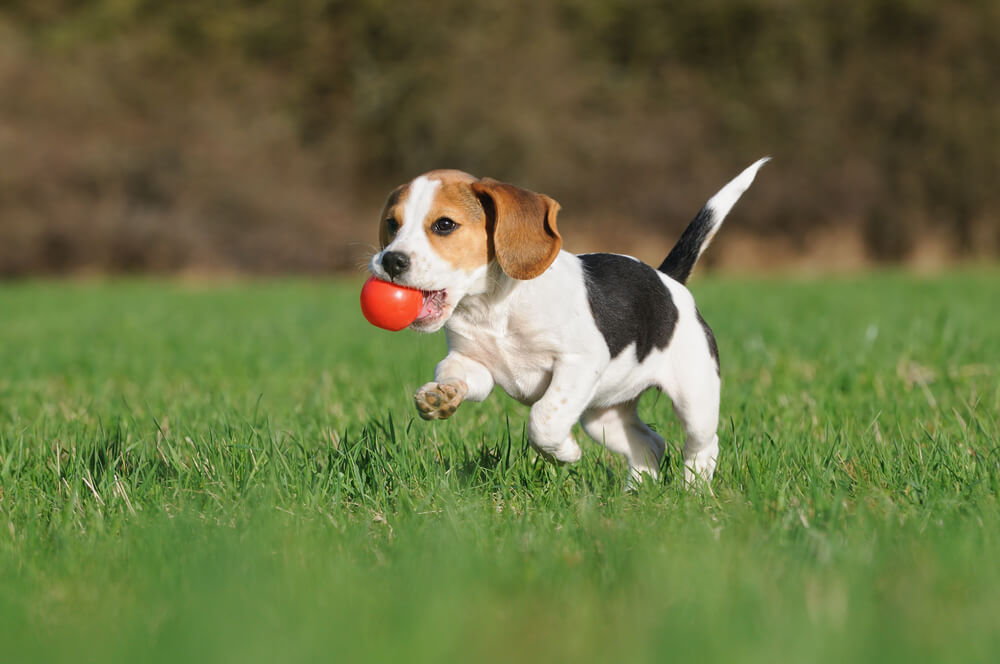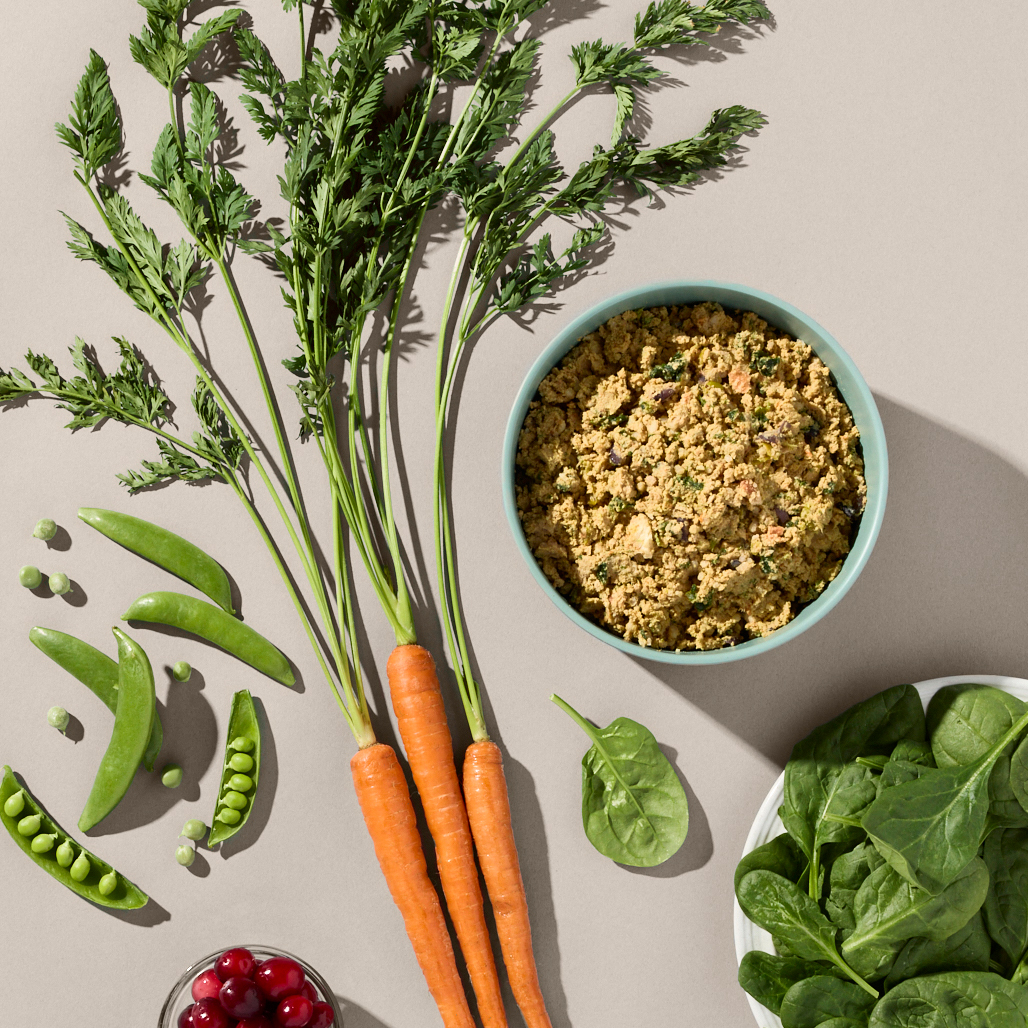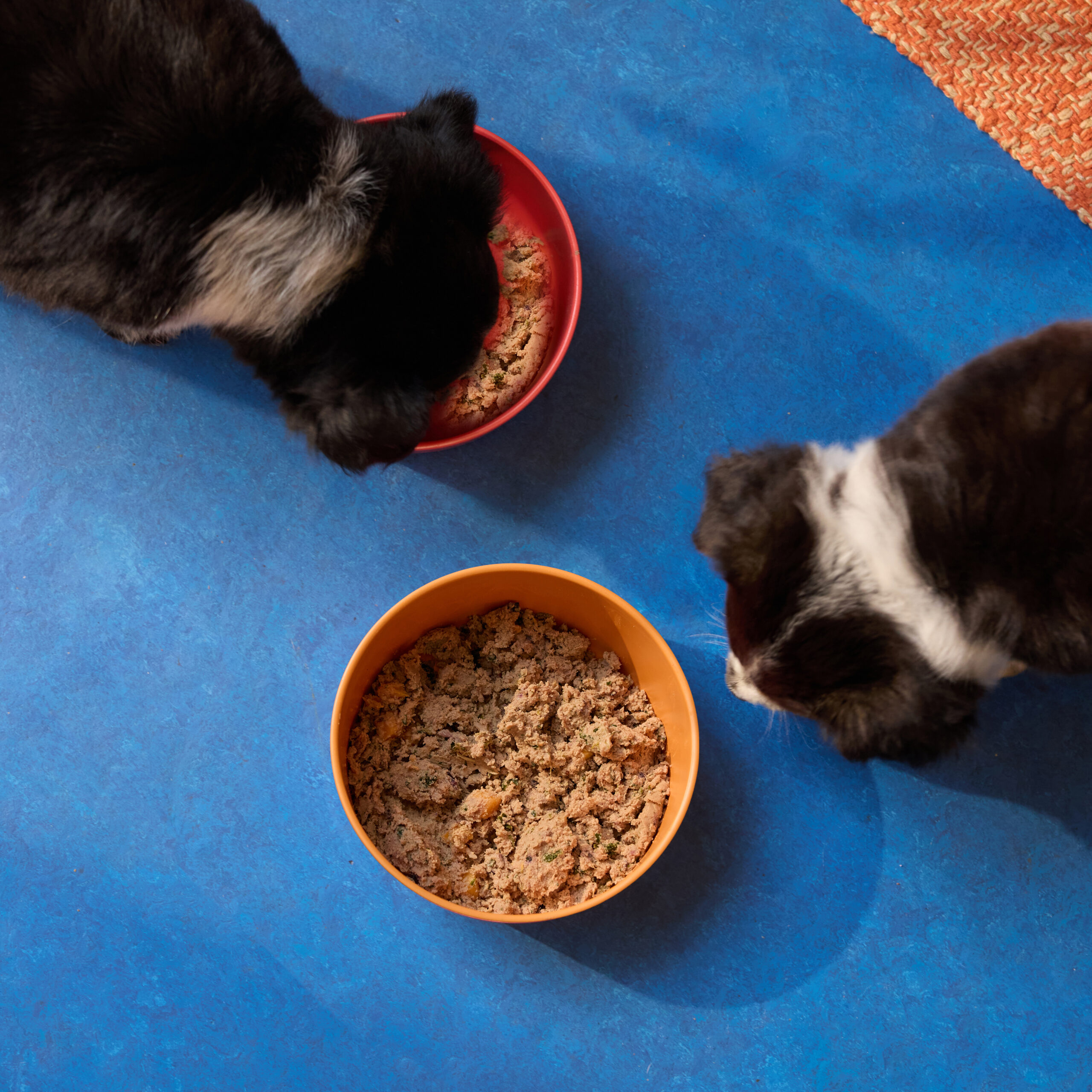Hey Ollie blog readers! We’re offering you an exclusive 60% OFF your starter box! Try now!
Making the switch to fresh food is one of the best things you can do for your dog’s health, but it’s not something you want to rush. Even if your pup is excited about their new meals, their digestive system needs time to adjust to the change.
That’s where a proper transition plan comes in.
Switching too quickly can lead to stomach upset, loose stools, or even skipped meals. But when you transition slowly and follow a vet-informed guide, like the one we use at Ollie, you can help your dog ease into their new diet without any drama.
In this article, we’ll walk you through the exact steps to transition your dog to fresh food, share signs to look for, and answer common questions from pet parents. Whether you’re brand new to fresh feeding or switching from another food, we’ve got your back.
Why You Should Transition Gradually
Your dog’s digestive system is sensitive to change, especially when switching from processed kibble to fresh, nutrient-dense food. A slow transition helps avoid the most common issue pet parents report: digestive upset.
Sudden changes in diet can shock your dog’s gut microbiome, leading to symptoms like soft stool, gas, or even vomiting. That’s why veterinarians and canine nutritionists agree: gradual transitions are key.
Dr. Linda Simon, MVB MRCVS mentioned that, a step-by-step food transition gives the digestive tract time to adapt, especially when switching to a higher quality diet.
At Ollie, we’ve developed a fresh dog food transition guide based on real-world success. Our 7-day method works for most dogs, but you can always adjust the pace based on how your pup is responding.
So if you’re wondering how to transition your dog to fresh food without the mess? The answer is: go slow, follow a proven plan, and keep an eye on how your dog feels along the way.
The Ollie 7-Day Fresh Food Transition Guide
The easiest way to transition to fresh dog food is to do it step by step. At Ollie, we recommend a 7-day transition plan that gives your dog’s digestive system time to adjust while getting them excited about their new meals.
Here’s how it works:
Days 1–2
Scoop a small amount of Ollie into your dog’s current food.
Think of it as a flavor teaser—just enough for their body to start recognizing the new ingredients.
Days 3–4
Mix 50% Ollie with 50% of their current food.
This is when your dog starts getting a real taste of the fresh stuff while still holding on to something familiar.
Days 5–6
Serve 75% Ollie and 25% old food.
By now, most dogs are eager for their full bowl of freshness. You’re almost there.
Day 7
Serve 100% Ollie.
Welcome to the fresh life! Your pup is officially transitioned.
Pro Tip:
Some dogs may need a little more time, especially if they’re used to eating only dry food. Don’t be afraid to stretch this schedule to 10 days or more if you notice loose stool or any hesitation.
Ollie meals are designed to be gentle on sensitive stomachs, but like people, every dog reacts differently to diet changes. Trust the process, and let your pup lead the pace.
How to Spot Signs Your Dog Is Adjusting Well
When you’re transitioning to fresh food, it’s important to know what “normal” looks like. Most dogs adjust smoothly, especially when the switch is done gradually. But how can you tell if the transition is on track?
Here are the green flags:
Normal Poops
Slight changes in stool are expected, but it should still be formed, not watery or frequent. A little softer at first is okay.
Eager Mealtime Behavior
If your dog is licking the bowl clean and wagging their tail at mealtime, you’re on the right track. Fresh food tends to excite even picky eaters.
Healthy Energy Levels
Your dog should seem like their usual self, playful, alert, and happy. Some pups even show more energy once they’re off heavily processed food.
No Signs of Discomfort
Watch for relaxed body language after meals. No pacing, gurgling stomachs, or licking their lips excessively, all signs they’re feeling good.
At Ollie, we design meals to be easy on sensitive stomachs and packed with nutrients that support digestion. If your dog is showing these positive signs, you’re likely transitioning just right.
When to Slow Down the Transition
Even with a solid plan, some dogs need a little extra time to adjust to fresh food, especially if they’ve been eating the same kibble for years.
Here are a few signs it might be time to ease up and go slower:
Loose or Frequent Stools
A little softness is normal, but watery or multiple stools in a day? That’s your cue to pause and stick with the current mix ratio for a few days before increasing the amount of Ollie.
Lack of Appetite
Some dogs are naturally cautious with new food. If your pup hesitates or skips meals, try warming Ollie slightly or mixing in a topper like plain pumpkin (approved by your vet).
Upset Stomach
Look out for gurgling noises, vomiting, or excess gas. These signs usually mean the transition is moving too fast and should be slowed down.
What To Do:
- Go back to the previous day’s ratio for a few extra days
- Make sure you’re storing and serving Ollie correctly (refrigerated, served fresh—not too cold)
- Keep everything else in your dog’s diet the same—no new treats or table food during the switch
The goal is long-term health, not a race. At Ollie, we believe in making fresh food a positive experience for every dog, no pressure, just progress.
Common Mistakes to Avoid
Transitioning to fresh food should be simple, but a few common missteps can make the process harder than it needs to be. Here’s what to watch out for:
Switching Too Quickly
Jumping straight to 100% fresh food might seem tempting (especially when your dog loves it), but skipping the gradual transition can upset their stomach.
Ignoring Portion Guidance
Fresh food is more calorie-dense than many dry foods. Using Ollie personalized portion guide helps ensure your dog gets the right amount without overfeeding.
Mixing With Poor-Quality Kibble
If you’re combining Ollie with kibble during the transition, make sure the kibble is high quality. Artificial additives or low-grade ingredients can interfere with digestion.
Introducing New Treats or Supplements
Stick to your dog’s usual treats during the switch. Changing too many variables at once can confuse things if your dog has a reaction.
Not Paying Attention to Signs
Your dog will give you clues, through their appetite, energy, and bathroom habits. If something seems off, it’s okay to slow down and recalibrate.
Transition Support Tools from Ollie
Switching your dog to fresh food doesn’t have to be a solo mission. Ollie offers tools and resources designed to make the transition smoother and more successful, for both you and your pup.
Digestive Check-Ins via The Ollie App
Our app includes built-in digestive screening so you can track your dog’s poop (yes, we said it) and energy levels during the transition. You’ll know if things are going well, or if it’s time to slow down a bit.
Personalized Portion Plans
When you sign up, Ollie builds a custom meal plan based on your dog’s age, breed, weight, and activity level. That way, you’re not guessing how much to feed during the switch.
Step-by-Step Transition Video
Prefer visual guides? Ollie provides a quick video walkthrough of the 7-day transition process, so you know exactly what to do and when to adjust.
Real-Time Support
Have a question? Our customer support team (yes, real humans who love dogs) is always here to help with personalized tips or transition advice.
Making the move to fresh food is a big step, but with Ollie tools, it feels less like a leap and more like a guided journey.
Frequently Asked Questions About Switching To Fresh Dog Food
How long does it take to transition a dog to fresh food?
Most dogs do well with a 7-day transition, gradually increasing the amount of fresh food each day. Some may need 10–14 days depending on their sensitivity.
What if my dog won’t eat the fresh food?
Try warming it slightly or mixing in a small amount of their current food to ease them in. You can also start with a lower ratio of fresh food and increase more slowly.
Can I mix fresh food with kibble permanently?
Yes, some pet parents choose to do a hybrid feeding plan. Just be sure to adjust portions to avoid overfeeding and keep both foods high-quality.
Should I refrigerate or warm up fresh food during the transition?
Ollie food should be stored in the fridge and can be served cold or gently warmed to room temperature, just never hot.
What if my dog has diarrhea during the transition?
It’s common for dogs to experience mild digestive changes. If diarrhea lasts more than a day or two, slow the transition or consult your vet.
Tagged As:

The nutrition your dog needs,
the food they want.

Enjoying our articles? Subscribe our Newsletters and get new articles directly to your inbox
You might also like
24 October 2025
6 MINS READ
Is Kibble Enough Nutrition? The Best Healthy Dog Food Alternatives
For decades, kibble has filled the bowls of pups everywhere as the default option for a dog’s diet, but is it truly enough? We’re diving into the world of canine nutrition, examining the limit…
by Ollie Pets
24 October 2025
5 MINS READ
How to Choose the Best Fresh Dog Food in 2025
With so many choices, what truly defines the best fresh dog food in 2025? We’re moving beyond the one-size-fits-all approach of traditional kibble and seeking nutrition that helps our dogs truly…
by Ollie Pets
24 October 2025
5 MINS READ
Why Puppies Thrive on Fresh Dog Food: Key Benefits
Bringing a new puppy home is an exciting milestone, but it also comes with a big responsibility: ensuring they get the best possible start in life. Nutrition during your puppy’s first year is cr…
by Ollie Pets







